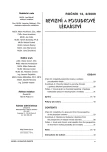Current experience from the control of historical prescription of medicaments
Authors:
L. Dvořáček
Authors‘ workplace:
Principal Business Consultant – Health, Adastra, s. r. o., Praha
Published in:
Listy rev. Lék., 13, 2009, č. 2, s. 31-36
Overview
Recently, there are no studies in the CR focused on assessing the quality of pharmacotherapy, especially with focus on drug interactions, prescription of related ATC groups or on occurence of other abnormalities in prescription.
Similarly, there are no statistics of hospitalizations due to undesirable drug effects – therefore the existing situation in quality of drug prescription can currently only be appraised or deduced from foreign experience (Pirmohamed M: BMJ 2004;329:15-19). The cited study of the team of the professor of clinical pharmacology at University Liverpool Munir Pirmohamed assesses the situation in two big general hospitals in Merseyside (Great Britain) with catchment area of 630 thousand inhabitants in the duration of 6 months. There were 18.820 patients admitted to hospitalization (in-patient care) in this period out of which 6.5 percent were admitted due to adverse drug effects. 16.6 percent of these cases were caused by drug interaction, 28 patients died, median of the hospitalization length was 8 days. These patients occupied 4 percent of the whole amount of the sickbeds. If we convert this data to the situation in the CR, we get very interesting numbers.
The article shows the real situation in the field of prescription in the CR based on wide controls implemented in the historical prescription of important health insurance companies in the CR and in important files of prescription of hospitals from the district ones to faculty hospitals. Special emphasis is laid on drug prescription with potential drug interactions, with prescription of related ATC groups and other abnormalities in drug prescription in 2007.
Key words:
drug prescription – drug interactions – drugs of related ATC groups – abnormalities in prescription – ePrescription – expert system for electronic prescription – prescription adequacy for the diagnosis – statistical evaluation of prescription – control of historica prescription – experience from control of prescription
Labels
Medical assessment Occupational medicineArticle was published in
Revision Medicine Journal

2009 Issue 2
Most read in this issue
- Health and social care and public health insurance reimbursement
- Current experience from the control of historical prescription of medicaments
- Experience from analyses of health documentation in inpatient facilities
